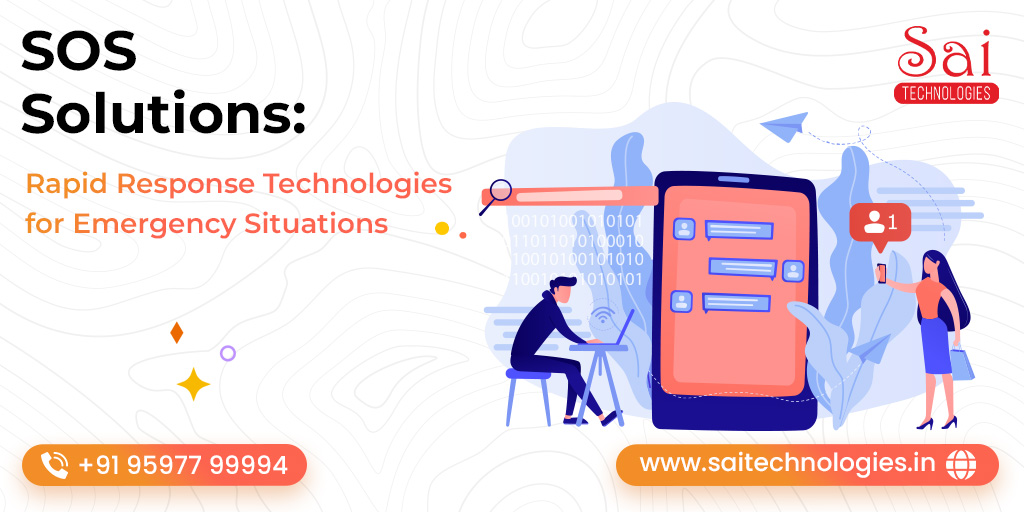SOS Solutions
Rapid Response Technologies for Emergency Situations

Introduction:
In a fast-paced world, emergencies happen all the time, whether it's a health crisis, an accident, or a threat to people's safety. In critical times like these, every second counts, so quick and effective solutions are needed to ensure people's safety and well-being. This is where SOS (Save Our Souls) solutions come in, using technology to respond quickly and help in emergencies. In this article, we will dive into the world of SOS solutions and explore new technologies and strategies to respond quickly and effectively.
Learn about SOS solutions
SOS solutions include a set of technologies and platforms designed to manage emergency communications, organize responses and deliver assistance. These therapies use various forms of communication, including mobile apps, wearables, and connected devices, to enable individuals to seek help when needed and to alert emergency responders. Whether requesting medical assistance during a natural disaster, reporting a crime, or requesting rescue, SOS solutions can help those in need.
Key components of the SOS solution
Mobile Apps: SOS mobile apps are probably the most common and accessible form of SOS solution. These apps allow users to send distress signals, share location, and communicate with emergency services and designated contacts at the touch of a button. Many SOS apps also include other features, such as medical information storage, time tracking, and integration with emergency response systems.
Wearable Devices: Wearable SOS devices, such as smart watches and wearable personal safety devices, are a convenient and intuitive way for individuals to seek help in an emergency. These devices have special SOS buttons or icons that trigger emergency alerts and notifications. Some SOS devices have additional features, such as heart rate and accelerometers, to automatically detect falls or accidents.
Connected Home Devices: Home SOS solutions use smart home devices and voice-activated assistants to provide emergency assistance in the home environment. The system can be integrated with home security systems, medical alarm devices, and emergency contact lists, allowing users to request help verbally or by automatically triggering an emergency such as fire, theft or sudden death.
On-site services: On-site SOS solutions use GPS and geolocation technology to know the exact location of people in distress. By providing accurate location information to emergency responders, this solution can quickly deliver aid and increase the chances of a successful rescue or intervention.
Advantages of SOS solutions
Quick response: SOS solutions provide quick and effective response to emergencies, helping to reduce response time and save lives in critical situations.
Better communication: SOS solutions improve communication between people in an emergency and emergency responders by providing clear and concise information about the nature and location of the emergency .
Enhanced security: SOS solutions allow individuals to take control of their safety and well-being, with help and peace of mind at the touch of a button.
Increased accessibility: With the proliferation of smartphones and wearable devices, SOS solutions have become more accessible to people of all ages and abilities, ensuring that emergency help is available to those who want it.
Integrate with existing systems: Many SOS solutions are designed to integrate seamlessly with existing emergency response systems, including 911 services, medical alert systems, and public safety agencies, making them easy to deploy assistance and resource coordination.
Challenges and ideas
While SOS solutions offer many benefits, there are challenges and considerations to address:
Security: Ensuring the reliability and availability of your SOS solution is important, as timing problems or technical issues can occur in an emergency.
Privacy and security: When developing and implementing SOS solutions, protecting the privacy and security of users' personal information and location data is essential, requiring strong data encryption and protective measures.
Training and Awareness: Teaching users how to use the SOS solution correctly and providing training on emergency procedures is important to increase its effectiveness and reduce false alarms and misuse. or Integration and collaboration: Achieving integration and collaboration between various SOS solutions and emergency response systems is critical to ensuring a responsive and effective response to emergencies.
Case studies and success stories
There are many international examples that demonstrate the usefulness and impact of SOS solutions in emergency situations:
Medical Services: The SOS app helps individuals get medical help in the event of a heart attack, stroke, or other life-threatening condition, and provides the bystanders to perform CPR or locate the nearest defibrillator.
Natural Resources: During natural disasters such as hurricanes, earthquakes, and forest fires, SOS solutions help with evacuations, provide updates and alerts, and enable survivors to communicate to caregivers and loved ones.
Personal Security: In situations involving threats to physical safety, SOS solutions allow individuals to proactively seek help, document evidence of crime, and monitor authorities. manage for potential risk.
Remote and vulnerable communities: SOS solutions have been found to be especially important in remote and vulnerable communities where access to emergency services is limited or non-existent, residents can find and receive help in an emergency. The SOS solution is not without challenges. Reliability is important and requires a robust system to ensure availability and continuous operation, especially in extreme situations. In addition, privacy and security issues must be carefully managed to protect sensitive user information and maintain trust in the system. Training and awareness programs are essential to teach users how to properly use SOS solutions, reduce false alarms, and ensure emergency response. In addition, integration and collaboration with existing emergency response infrastructure is essential to maximize the efficiency and effectiveness of your SOS solution. Despite these challenges, the revolutionary potential of SOS solutions to reduce risk, save lives and increase community resilience demonstrates their importance in the modern emergency management paradigm.
To decide
SOS solutions are a powerful and essential tool for solving emergencies and protecting lives in today's connected world. Using innovative technologies and strategies, these solutions can provide quick and helpful responses, helping individuals overcome problems and navigate difficult situations.

